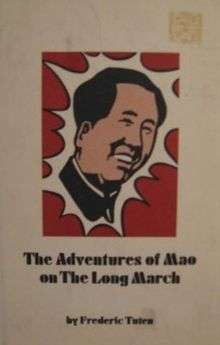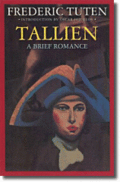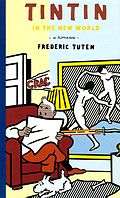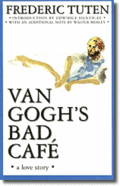Frederic Tuten
| Frederic Tuten | |
|---|---|
 | |
| Born |
1936 (age 79–80) The Bronx, New York City, United States |
| Occupation | Novelist, short story writer and essayist |
| Nationality | United States |
| Period | 1964–present |
| Website | |
|
www | |
Frederic Tuten (born December 2, 1936) is an American novelist, short story writer and essayist. He has written five novels – The Adventures of Mao on the Long March (1971), Tallien: A Brief Romance (1988), Tintin in the New World: A Romance (1993), Van Gogh's Bad Café (1997) and The Green Hour (2002) – as well as one book of inter-related short stories, Self-Portraits: Fictions (2010), and essays, many of the latter being about contemporary art.
Biography
Born in 1936[1] in The Bronx, New York City, New York, in the United States, Tuten is the son of a Sicilian mother and a French-Huguenot father. His father left their family when Tuten was young, and though they were never close, his father eventually was a part of Tuten's life before his death.
Tuten received his undergraduate degree from the City College of New York. After studying pre-Columbian art history at the National Autonomous University of Mexico and travelling through South America writing on Brazilian cinema, he earned a Ph.D. in 19th-century American literature from New York University, concentrating on Melville, Whitman, and James Fenimore Cooper, and taught literature and American cinema in France at the University of Paris VIII: Vincennes—Saint-Denis.[2]
Tuten spent 15 years heading the graduate program in creative writing at the City College of New York, which he co-founded. In that capacity, he championed the work of students Walter Mosley, Oscar Hijuelos, Philip Graham, Aurelie Sheehan, Salar Abdoh, Ernesto Quiñonez, and many others. He also teaches classes on experimental writing at The New School. He is on the board of advisors for Guernica Magazine and executive editor of Smyles & Fish. Tuten's short fiction has appeared in Granta, Conjunctions, Fence, Fiction, The New Review of Literature, Tri-Quarterly, and Harper's Magazine. In 1973, he received a Guggenheim Fellowship for Creative Writing and in 2001 was given the Award for Distinguished Writing from the American Academy of Arts and Letters.[2] In describing his usage of the past in his novels (where many of them are set), Tuten once stated:
The fact that I don’t write about contemporary life doesn’t mean I’m any less taken up with it. I find it too limiting to write about contemporary life just in contemporary diction, however. I don’t think there’s enough flexibility. I can imagine writing about characters who feel passion for one another in a contemporary setting but I don’t, as yet, hear the language for that. But I’m always thinking about contemporary life vis a vis the way it looks in the past. I mean how it looks in the past is a reflection of what it is today. That’s what interests me. I think I’m always talking about present-day life, not only political life but about the quality of passion, the quality of all relationships and love.[3]
Tuten is also a well-known figure within the art world. He has worked as an art and film critic in various venues such as the New York Times and Artforum and often incorporates allusions to these fields in his fiction as well. Tuten was a close personal friend of Roy Lichtenstein and published several essays on his work, as well as catalogue essays for many other artists including John Baldessari, Ross Bleckner, Eric Fischl, R.B. Kitaj, and David Salle.
Tuten currently resides in New York City's East Village.
Works
Novels

Tuten's first novel, The Adventures of Mao on the Long March (1971),[4] a fictionalized account of Chairman Mao's rise to power, is highly experimental in nature. It contains Faulkneresque changes in narrative and lengthy fictional conversations with Mao that read like journalistic interviews. The story first appeared in 1969 in a 39-page condensed form in the magazine Artist Slain. The novel in its entirety was subsequently published by Citadel Press in 1971, and re-released in 2005 by New Directions.
The cover of Mao features original artwork by painter Roy Lichtenstein. This is fitting for Tuten whom, in life as in his novels, has a keen interest in artistic criticism (particularly with regard to painting). Tuten himself was actually used as a model for the drawing, which Lichtenstein altered accordingly to resemble Mao.

His next novel, Tallien: A Brief Romance (1988),[5] is also about an historical figure, though one not nearly as well known as Mao. Jean Lambert Tallien was a high-ranking figure in the French Revolution, serving as the president of the Constitutional Convention and a member of the Committee of Public Safety. Like Mao, Tallien was a member of the common classes who rose to the upper crust of the revolutionary ranks.
Tuten tells the story of Tallien's courtship and marriage to Therese, a condemned member of the French aristocracy. When eyebrows are raised by Tallien's show of clemency, Tuten describes in minute organizational detail the sometimes-banal and sometimes-bloody bureaucratic struggle that ensues. The narrative is intercut with the author's account of his own father's life, demonstrating an illiquid literary mechanism similar to that used in The Adventures of Mao.

Tintin in the New World (1993)[6] is perhaps Tuten's best known and most critically acclaimed work. The novel's unlikely protagonist is Tintin, the cartoon boy detective created by Belgian comic artist Georges Remi, better known as Hergé. Tuten transplants Tintin from his comic book confines into a fleshed out, realistic world with all its wicked, grave and abstruse trappings. Appreciation of the book is enhanced by an acquaintance with Thomas Mann's The Magic Mountain, the characters of which it uses.
The cover of the novel, like The Adventures of Mao, features a drawing by Roy Lichtenstein, which was created expressly for the novel. Again Lichtenstein makes use of the benday dot technique to depict Tintin and his dog Snowy in a near-miss with a would-be assassin's knife. Behind Tintin hangs the painting Dance (I) by Henri Matisse, which in reality is displayed in the Museum of Modern Art in New York City. Roy Lichtenstein's own rendering of Dance, sans Tintin, hangs in the same museum.
The book went through several print runs, both in the United States and the UK (in Britain, the novel was published by Marion Boyars Publishers, and later Minerva). The novel was also translated into French, German, Dutch, Spanish, Catalan, and Swedish. In 2005, it was re-released by Black Classics Press in the USA, with an introduction by Paul LaFarge. All editions of the book feature the Interior with Painting of Tintin jacket illustration created by Lichtenstein.

Like Mao and Tallien, Tuten's next novel, Van Gogh's Bad Café (1997),[7] offers an imagined glimpse into the psyche of a historical character, Dutch artist Vincent van Gogh. The book is also similar to Mao in that the time and place of action and the narrator are inconsistent throughout and change without warning. Van Gogh's Bad Café explores the themes of love and addiction.
Tuten's most recent novel, The Green Hour (2002),[8] is in many ways a departure from the others. The setting is the present day, and the characters are not borrowed from history. Further, it lacks much of the impertinent humor and ethereal feel of his previous works. The story recounts the 30-year love affair between an academic and a spiritual vagabond.
Several of Frederic Tuten's novels and short stories feature a cat named Nicolino.
"The Collagists"
In 2007 Tuten was asked by literary website Smyles and Fish, along with lifelong friend Jerome Charyn, to write an essay about their former colleague and friend Donald Barthelme. The project evolved into a lengthy article, which offers a sort of collage of these three writers and the world of their influences. The work is divided into three parts - an introductory essay on the project by editor-in-chief Iris Smyles, Charyn's essay on Barthelme, and Tuten's piece "My Autobiography: Portable with Images", into which Tuten embedded illustrations by Max Ernst and quotes from Barthelme's works.[9]
Short stories
- "My Autobiography : Portable, with Commentary", Conjunctions 40, Spring 2003.
- "In the Borghese Gardens," The New Review of Literature Vol. 1, October 2003.
Tuten's first collection of short stories entitled Self Portraits: Fictions was published by W. W. Norton on 13 September 2010 and includes the following stories:
- "The Park Near Marienbad", Conjunctions 42, Spring 2004.
- "Voyagers", Conjunctions 44, Spring 2005.
- "The Park in Winter," Fence Vol.8, Summer 2005.
- "The Ship at Anchor", Granta 91, September 2005.
- "Self Portrait with Icebergs", KGB Bar Lit, 2005.
- "Self Portrait with Cheese", "Roy Lichtenstein: Conversations with Surrealism, Exhibition Catalogue: Mitchell-Innes & Nash, October 2005; reprinted in Smyles & Fish 1, Fall 2006.
- "Self Portrait with Beach", Mona Kuhn : Evidence, 2007 ISBN 3-86521-372-3; reprinted in Conjunctions 48, Spring 2007, and in Harper's, August 2007;
- "Self Portrait with Sicily," Conjunctions, Spring 2008.
- "The Bar on Tompkins Square Park: Self Portrait with Blue Horse", BOMB Magazine, Summer 2009.
- "The Park on Fire"
- "Self Portrait with Circus"
- "Self Portrait with Bullfight"
Essays
- "Trova." Arts Mag., XLIII (December 1968 – January 1969), 32–33.
- "Roy Lichtenstein Bronze Sculpture 1976–1989." 65 Thompson Street, 1989.
- "Twenty-Five Years After : The Adventures of Mao on the Long March." Archipelago, 1997.
- Tuten, Frederic (1997). "David Salle: At the Edges". Art in America. F.F. Sherman. 85 (9): 78..
- "Still Replying to Grandma's Persistent 'And Then?'" Writers on Writing (2002). - reprinted as a prologue to the short story collection Self Portraits: Fictions
- Tuten, Frederic (May 2005). "An Excerpt from Tintin in the New World". Guernica Magazine. Retrieved 2007-06-15.
- Frederic Tuten / December Guest Editor. Guernica Magazine, 2006. Frederic Tuten comments on fiction from four selected writers whose work he edited for Guernica Magazine.
Other writings
Tuten has contributed to the following books:
- R.B. Kitaj Pictures. Marlborough Gallery, 1974.
- Roy Lichtenstein: Water Lilies. Richard Gray Gallery, 1992.
- David Salle. Gagosian Gallery, 1999.
- Roy Lichtenstein: Early Black and White Paintings. Gagosian Gallery, 2002.
- Eric Fischl: Paintings And Drawings 1979-2001. Hatje Cantz, 2003. ISBN 3-7757-1379-4
- John Baldessari. Ecole normale supérieure des beaux-arts, 2005. ISBN 2-84056-200-6
- Roy Lichtenstein: Conversations With Surrealism. Mitchell-Innes & Nash, 2006. ISBN 0-9749607-4-8
Tuten also co-wrote the 1981 cult movie Possession with its director, Andrzej Zulawski.[10]
Notes
- ↑ "Tuten, Frederic". Harper's Magazine. Retrieved 2007-09-23.
- 1 2 Tuten, Frederic (2005). "Self Portrait with Icebergs". KGBBarLit. Retrieved 2007-06-15.
- ↑ Wolmer, Bruce. "Frederic Tuten Interview" BOMB Magazine Winter, 1989. Retrieved May 22, 2013.
- ↑ Tuten, Frederic (1971). The Adventures of Mao on the Long March. New York, N.Y.: Citadel Press. ISBN 0-8065-0248-7. Reprinted as Tuten, Frederic (1977). The Adventures of Mao on the Long March. New York, N.Y.; London, England: Marion Boyars. ISBN 0-7145-3021-2.; Tuten, Frederic (2005). The Adventures of Mao on the Long March. New York, N.Y.: New Directions Classic. ISBN 0-8112-1632-2.
- ↑ Tuten, Frederic (1988). Tallien : A Brief Romance. New York, N.Y.: Farrar, Straus & Giroux. ISBN 0-374-27249-2. Reprinted as Tuten, Frederic (1989). Tallien : A Brief Romance. [S.l.]: Weidenfeld & Nicolson. ISBN 0-297-79317-9.; Tuten, Frederic (1995). Tallien : A Brief Romance. New York, N.Y.: Marion Boyars. ISBN 0-7145-2990-7.; Tuten, Frederic (2005). Tallien : A Brief Romance. Baltimore, Md.: Black Classics Press. ISBN 1-58073-035-3.
- ↑ Tuten, Frederic (1993). Tintin in the New World : A Romance. New York, N.Y.: W. Morrow. ISBN 0-688-12315-5.; Tuten, Frederic (1993). Tintin in the New World : A Romance. London: Marion Boyars. ISBN 0-7145-2978-8. Reprinted as Tuten, Frederic (1996). Tintin in the New World : A Romance (1st Riverhead ed.). New York, N.Y.: Riverhead Books. ISBN 1-57322-529-0.; Tuten, Frederic (2005). Tintin in the New World : A Romance. Baltimore, Md.: Black Classics Press. ISBN 1-58073-033-7.
- ↑ Tuten, Frederic (1997). Van Gogh's Bad Café : A Love Story. New York, N.Y.: W. Morrow. ISBN 0-688-15134-5.; Tuten, Frederic (1997). Van Gogh's Bad Café : A Love Story. London: Marion Boyars. ISBN 0-7145-3030-1. Reprinted as Tuten, Frederic (2005). Van Gogh's Bad Café : A Love Story. Baltimore, Md.: Black Classics Press. ISBN 1-58073-034-5.
- ↑ Tuten, Frederic (2002). The Green Hour. New York, N.Y.: W.W. Norton & Co. ISBN 0-393-05105-6.
- ↑ "The Collagists" Smyles & Fish, available online May 2008
- ↑ http://www.tcm.com/this-month/article/382629%7C443278/Possession.html
Further reading
- An Inventory of the Literary Archive of Frederic Tuten. [Cambridge, Mass.]: Lame Duck Books. c. 2005.
- Les aventures de Mao en Amérique. Véronique Béghain [Paris]: Presses Universitaires de France. 2008.